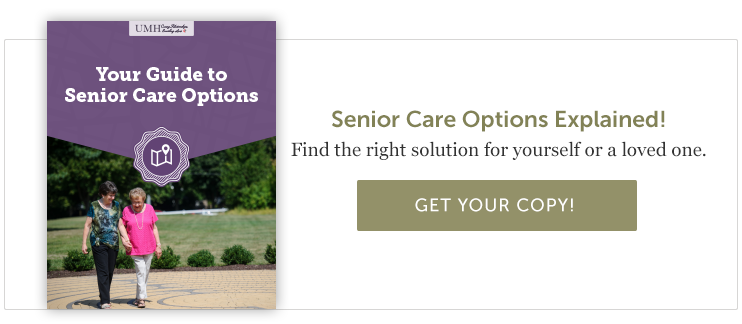Senior Nutrition: Healthy Eating for Older Adults
Independent Senior Living | senior living nutrition | senior living homes | Aging & Caregiving | dependent senior living
The aging process is an interesting one for sure. And like any other phase of life, one’s golden years are accompanied by unique ups and downs, joys and sorrows, moments of anxiety and moments of peace. There are changes to mind, body and spirit. There are new things to learn and new opportunities to embrace. And while there’s no stopping the aging process, there’s much that can be done to live your senior years with the utmost satisfaction and enjoyment.
In most cases, this journey is best supported by a healthy approach to diet and nutrition.
The first step toward maximizing physical and mental health as an older adult is learning to eat right. Sure, you probably know the basics of nutrition, but as you age, it becomes more important than ever to develop a strong plan for maintaining a healthy diet. And doing so doesn’t have to be complicated, daunting or boring.
To help you (or the senior in your life) create the kind of approach to healthy eating that fosters energy, strength, mental acuity and a host of other benefits, this article offers valuable insights, tips and recommendations from the experts.
Let’s dive right in!
Understanding How Aging Affects Appetite
It’s easy to spot the obvious signs of aging, like wrinkling skin and graying hair, but the ones that occur deep within our bodies are much less conspicuous. From digestion and metabolism to thirst and appetite, there are lots of internal shifts happening over the course of the aging process. Unfortunately, some of these changes can inhibit our habits for healthy eating.
According to Harvard Health Publishing contributor Katherine D. McManus, MS, RD, LDN, the physiological changes that accompany aging—even in healthy older adults—can result in:
- Reduced calorie needs
- Decreased food intake
- Altered body composition
- Diminished smell and taste
- Shifts in hormone levels that affect how quickly you feel full
She also indicates that common challenges experienced at this stage of life, like depression, lack of independence and social isolation, can make food seem less appealing, which further diminishes your likelihood to consume the ideal amount and types of foods.
In addition, there are some chronic diseases and physical problems that impact appetite, energy need and weight in older adults, such as:
- Heart disease
- Stroke
- Parkinson’s disease
- Cancer
- Diabetes
- Dementia
- Oral and dental issues that inhibit chewing or swallowing
And seniors on one or more medications may be subject to a drug’s interaction with certain nutrients. They could even be prone to side effects like:
- Nausea
- Vomiting
- Sensory changes that affect smell and taste
“All of these factors,” says McManus, “can lead to decreased intake of calories and nutrients, resulting in unplanned weight loss and lack of energy.”
To overcome these challenges and maintain the kind of diet that supports a healthier lifestyle, it’s important to stay on top of your nutrition. And while this may seem daunting or complicated, it certainly doesn’t have to be.
Top Tips for Maintaining Proper Nutrition
The Academy of Nutrition and Dietetics advises that you start with these recommendations from the Dietary Guidelines for Americans:
- Eat fruits and vegetables. They can be fresh, frozen or canned. Eat more dark green vegetables such as leafy greens or broccoli, and orange vegetables such as carrots and sweet potatoes.
- Vary protein choices with more fish, beans and peas.
- Eat at least three ounces of whole-grain cereals, breads, crackers, rice or pasta every day. Choose whole grains whenever possible.
- Have three servings of low-fat or fat-free dairy (milk, yogurt or cheese) that are fortified with vitamin D to help keep your bones healthy.
- Make the fats you eat polyunsaturated and monounsaturated fats. Switch from solid fats to oils when preparing food.
For even more specific guidance on how to make healthy eating a reality in your life, consider checking out the National Institute on Aging’s sample menus.
These easy menus provide 2,000 calories a day—without exceeding the recommended amount of sodium or calories from saturated fats and added sugars. Of course, you might need to eat fewer or more calories, depending on your height, weight, activity level and gender. So be sure to check with your doctor or nutritionist, and get a clearer understanding of your ideal caloric intake.
There are three additional recommendations from the NIA that are particularly important for older adults to heed:
- Stay hydrated! With age, you may lose some of your sense of thirst, but it’s critical to drink water often. Drinking low-fat or fat-free milk or 100% juice also helps you stay hydrated, though you should limit beverages that have lots of added sugars or salt and learn which liquids are the healthier choices.
- Keep your food safe! A food-related illness can be life-threatening for an older person, so definitely throw out anything that’s past its shelf life or might not be safe to consume. Avoid certain foods that are always risky for an older person, such as unpasteurized dairy foods. And be on the lookout for items that can be harmful to you when they are raw or undercooked, such as eggs, sprouts, fish, shellfish, meat or poultry.
- Talk to your doctor! Food is the best way to get the nutrients you need, but you may be a candidate for vitamins or supplements that can aid your nutrition. Your doctor will know if you need them. Some can interfere with your medicines or affect your medical conditions, so don’t start taking anything unless you’ve been specifically advised by your doctor.
Getting Creative with Healthy Eating
Adopting a healthy approach to eating comes with its own unique set of challenges as individuals age. From difficulties grocery shopping and compromised energy levels to potential boredom with the associated foods and routines, you may need a boost of creativity to help navigate the roadblocks. Check out these useful tips.
- Don’t have the time or energy to manage cooked meals that require multiple pots, pans and recipes? Think about trying easy one-pot or slow cooker options that cut down on the stress and mess of meal prep.
- Not so easy to get out to the grocery store? Consider looking into one of the many grocery and/or meal delivery services out there.
- Can’t justify the effort when you’re just cooking for one? Plan to make meals in batches, then store in one-serving containers that can be kept frozen or refrigerated for quick and simple access throughout the week.
- Keeping a close eye on food-related expenses? If you have a green thumb and the available space, start a small garden of fruits and vegetables that you can harvest and eat year-round.
- Struggle with dental or periodontal issues? Research softer food options, and stick to lots of cooked and canned offerings, keeping an eye toward staples like low-sodium soups and unsweetened fruits.
- Need to spice things up? Get social with your prepping and eating routines. Spend time cooking with a friend or family member, and enjoy the fruits of your labor over a shared meal together.
- Require a little instruction in the kitchen? Check out online classes and tutorials to learn all about food planning, preparation and cooking.
When you put your mind to it, there’s no limit to the possibilities involved in embracing healthy eating. It’s a critical key to maintaining a healthy and active lifestyle for years to come.
For additional tips on senior health and lifestyle issues, check out our blog. If you’re interested in learning more about United Methodist Homes senior living community, contact us today.
About Elizabeth Bemis
In 1998, I drove past an assisted living community construction site, learned that it was part of United Methodist Homes and realized the next stop on my professional journey was to work for a mission driven organization. Soon after, I joined the team as Executive Director of our Middlewoods of Farmington community and later served as Regional Manager for the Middlewoods properties before accepting my current role as Vice President of Marketing, Promotions, and Assisted Living Operations. I enjoy spending time with my family, cooking, reading, walking, and love working alongside our staff, residents, and families to build strong communities that reflect the mission, vision, and values of United Methodist Homes.

Our Blog is a 2016 Platinum Generations Award Winner! The Generations Award is an annual international competition for excellence in senior marketing recognizing professionals who have communicated to the 50+ Mature Markets.




